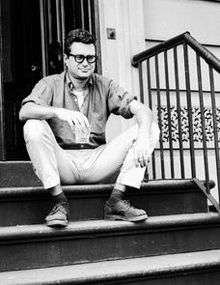Seymour Krim

Seymour Krim (May 11, 1922 – August 30, 1989) was an American author, editor and literary critic.[1] He is often categorized with the writers of the Beat Generation. He wrote for the Village Voice, Playboy, New York Element and International Times, among many other publications. He worked for a time at The New Yorker, where Brendan Gill recalled he was often "stripped to the waist."
Career
Krim was part of the New Journalism movement of the 1960s. His deepest foray into daily journalism began in 1965 when he joined the New York Herald Tribune′s staff which included Jimmy Breslin, Tom Wolfe and Dick Schaap.[1] While at the Trib for the last months of its life, he wrote articles that stirred a response among the city's literati as well as in the city room. His big, rolling prose was often laced with a startling, often funny, candor that connected with the emerging creative mind. In his introduction to Jack Kerouac's novel Desolation Angels, published in 1965, Krim brilliantly made the case for Kerouac's place in the annals of American literature.
Krim was born in the Washington Heights section of Manhattan, and spent much of his time in New York City. He taught writing seminars at a number of universities in the United States and abroad (including Mexico and Israel). For several years during the early 1980s he served as head of The Writers Workshop in Iowa City. In 1960, he was given the Longview Award for Literature. In 1976 he won a John Simon Guggenheim Fellowship and in 1985 a Fulbright grant. After suffering from a number of physical setbacks, including a debilitating heart attack, Krim committed suicide in his one-room apartment on East 10th Street by an overdose of barbiturates on August 30, 1989, at the age of 67 years, 3 months, and 19 days.[1]
Posthumous
In the years since his death, Krim's work has been notably missing from almost every Beat anthology, including The Portable Beat Reader, The Beat Book, The Birth of the Beat Generation and the Rolling Stone Book of the Beats. The reason for this is not clear, though the fact that the Beat movement is closely associated with poetry — and Krim was not a poet — may be a contributing factor. Still, Krim retains champions who have kept some of his essays in print. Phillip Lopate published Krim's "For My Brothers and Sisters in the Failure Business" in his 1997 anthology, The Art of the Personal Essay. In 2001, Saul Bellow included "What's This Cat's Story?" in Editors: The Best from Five Decades. And in 2001, critic Vivian Gornick praised Krim as "a Jewish Joan Didion" in her book The Situation and the Story. Gornick also included Krim's "Failure Business" on her list of the Ten Greatest Essays, Ever.
A new collection of Krim's work from Syracuse University Press, Missing a Beat: The Rants and Regrets of Seymour Krim, edited and with an introduction by Mark Cohen, argues that Krim should be seen primarily as a Jewish-American author and part of the same cultural and literary moment that in the late 1950s and early 1960s brought to prominence Philip Roth, Saul Bellow, Norman Mailer, and other writers who made Jewish-American literature prominent at that time.
Bibliography
- Manhattan: Stories of a Great City (1954; editor)
- The Beats (1960; editor)
- Views of a Nearsighted Cannoneer (1961)
- Shake It For The World, Smartass (1970)
- You and Me (1974)
- What's This Cat's Story? (1991 Posthumous compilation)
References
- 1 2 3 "Seymour Krim, 67, Author and Essayist". The New York Times.